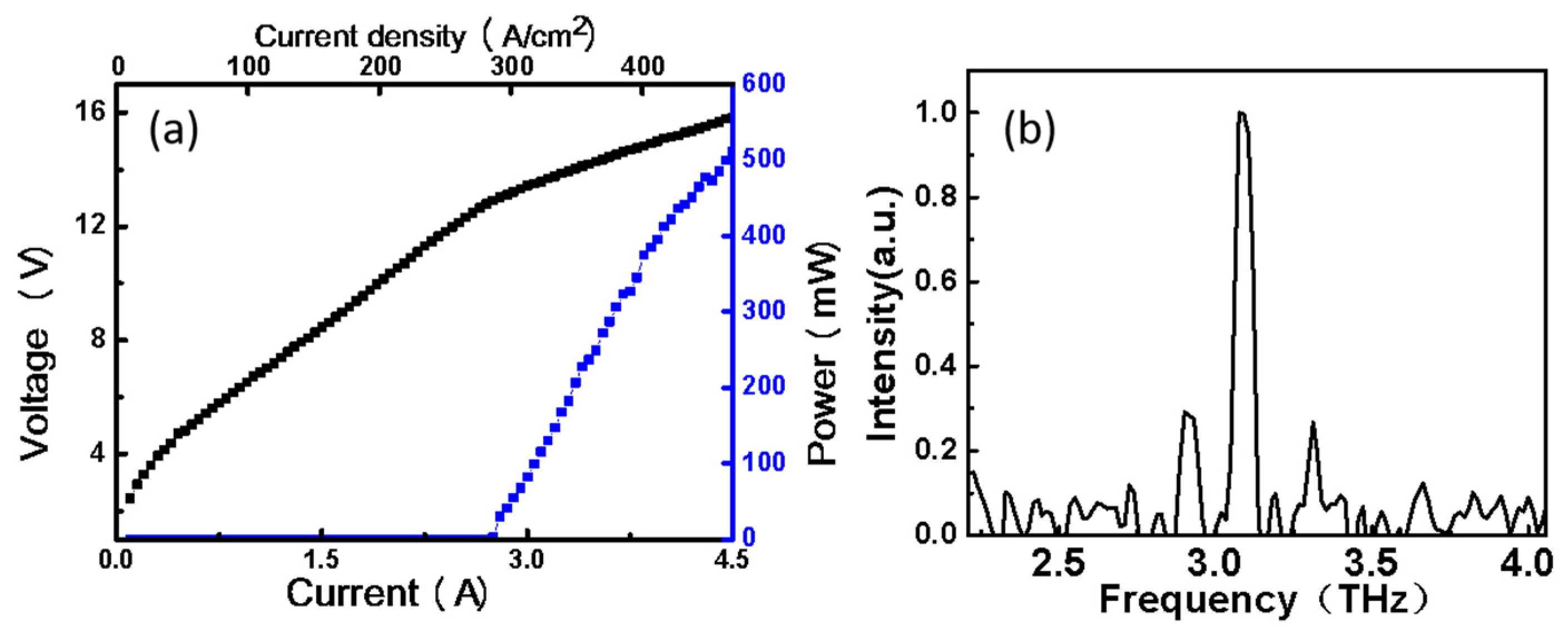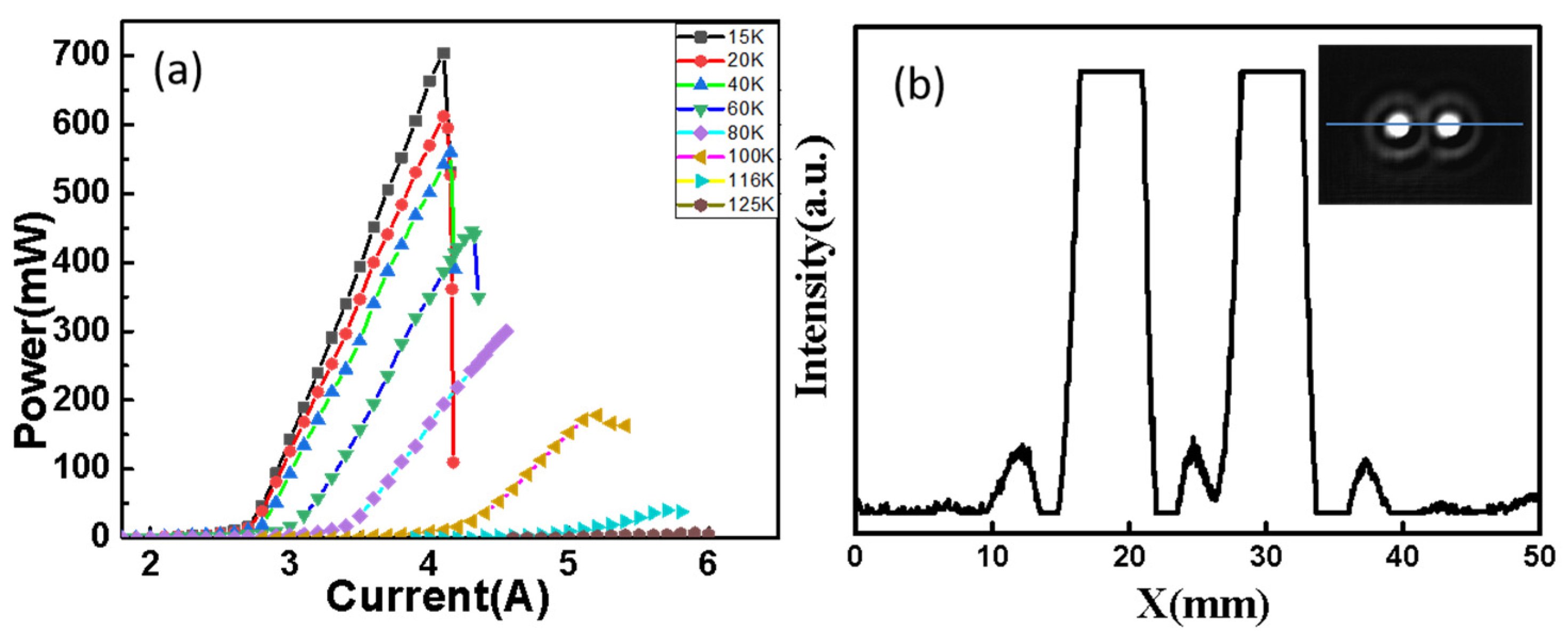A Study on the Photoelectric Properties of Dual Ridge Terahertz Quantum Cascade Lasers at 3.1 THz
Abstract
:1. Introduction
2. Design and Fabrication
3. Results and Discussion
4. Conclusions
Author Contributions
Funding
Data Availability Statement
Conflicts of Interest
References
- Ferguson, B.; Zhang, X.C. Materials for terahertz science and technology. Nat. Mater. 2002, 1, 26–33. [Google Scholar] [CrossRef] [PubMed]
- Liu, H.B.; Chen, Y.Q.; Basitiaans, G.J.; Zhang, X.C. Detection and ientification of explpsive RDX by THz diffuse reflcetion spectroscopy. Opt Express 2006, 14, 415–423. [Google Scholar] [CrossRef] [PubMed]
- Shen, Y.C.; Lo, T.; Taday, P.F.; Cole, B.E.; Tribe, W.R.; Kemp, M.C. Detection and identification of explosives using terahertz pulsed spectroscopic imaging. Appl. Phys. Lett. 2005, 86, 241116. [Google Scholar] [CrossRef] [Green Version]
- Tribe, W.R.; Newnham, D.A.; Taday, P.F.; Kemp, M.C. Hidden object detection: Security applications of terahertz technology. In Proceedings of the Integrated Optoelectronic Devices, San Jose, CA, USA, 26–29 January 2004; Volume 5354, pp. 168–176. [Google Scholar]
- Lim, Y.L.; Dean, P.; Nikolic, M.; Kliese, R.; Khanna, S.P.; Lachab, M.; Valavanis, A.; Indjin, D.; Ikoni’c, Z.; Harrison, P.; et al. Demonstration of a self-mixing displacement sensor based on terahertz quantum cascade lasers. Appl. Phys. Lett. 2011, 99, 081108. [Google Scholar]
- Sterczewski, L.A.; Westberg, J.; Yang, Y.; Burghoff, D.; Reno, J.; Hu, Q.; Wysocki, G. Terahertz spectroscopy of gas mixtures with dual quantum cascade laser frequency comb. ACS Photonics 2020, 7, 1082–1087. [Google Scholar] [CrossRef]
- Dunn, A.; Poyser, C.; Dean, P.; Demić, A.; Valavanis, A.; Indjin, D.; Salih, M.; Kundu, I.; Li, L.H.; Akimov, A.; et al. High-speed modulation of a terahertz quantum cascade laser by coherent acoustic phonon pulses. Nat. Commun. 2020, 11, 835. [Google Scholar] [CrossRef] [Green Version]
- Citrin, D.S.; Crowe, T.W.; Roskos, H.; Shen, Y. Terahertz sources and detectors and their application to biological sensing-Discussion. Philos. Trans. A Math. Phys. Eng. 2004, 362, 365–374. [Google Scholar]
- Smye, S.W.; Chamberlain, J.M.; Fitzgerald, A.J.; Berry, E. The interaction between terahertz radiation and biological tissue. Phys. Med. Biol. 2001, 46, 101. [Google Scholar] [CrossRef]
- Davies, A.G.; Burnett, A.D.; Fan, W.; Linfield, E.H.; Cunningham, J.E. Terahertz spectroscopy of explosives and drugs. Mater. Today 2008, 11, 18–26. [Google Scholar] [CrossRef]
- Kohler, R.; Tredicucci, A.; Beltram, F.; Beere, H.E.; Linfield, E.H.; Davies, A.G.; Ritchie, D.A.; Iotti, R.C.; Rossi, F. Terahertz semiconductor-heterostructure laser. Nature 2002, 417, 156–159. [Google Scholar] [CrossRef]
- Kumar, S. Quantum cascade lasers operating from 1.4 to 4 THz. Chin. Opt. Lett. 2011, 9, 110003. [Google Scholar] [CrossRef]
- Danylov, A.A.; Waldman, J.; Goyette, T.M.; G.atasman, A.J.; Reno, J.L. Transformation of the multimode terahertz quantum cascade laser beam into a Gaussian,using a hollow dielectric wave guide. Appl. Opt. 2007, 46, 5051–5055. [Google Scholar] [CrossRef] [PubMed]
- Jin, Y.; Reno, J.L.; Kumar, S. Phase-locked terahertz plasmonic laser array with 2 W output power in a single spectral mode. Optica 2020, 7, 708–715. [Google Scholar] [CrossRef]
- Williams, B.S. Terahertz quantum cascade lasers. Nat Photon 2007, 1, 517–525. [Google Scholar] [CrossRef] [Green Version]
- Scalari, G.; Walther, C.; Fischer, M.; Terazzi, R.; Beere, H.; Ritchie, D.; Faist, J. THz and sub-THz quantum cascade lasers. Laser Photonics Rev. 2009, 3, 45–66. [Google Scholar] [CrossRef]
- Li, L.H.; Chen, L.; Freeman, J.R.; Salih, M.; Dean, P.; Davies, A.G.; Linfield, E.H. Multi-Watt high-power THz frequency quantum cascade lasers. Electron. Lett. 2017, 53, 799–800. [Google Scholar] [CrossRef] [Green Version]
- Khalatpour, A.; Paulsen, A.K.; Deimert, C.; Wasilewski, Z.R.; Hu, Q. High-power portable terahertz laser systems. Nat. Photonics 2021, 15, 16–20. [Google Scholar] [CrossRef]
- Brandstetter, M.; Deutsch, C.; Krall, M.; Detz, H.M.; MacFarland, D.C.; Zederbauer, T.; Andrews, A.M.; Schrenk, W.; Strasser, G.; Unterrainer, K. High power terahertz quantum cascade lasers with symmetric wafer bonded active regions. Appl. Phys. Lett. 2013, 103, 171113. [Google Scholar] [CrossRef] [Green Version]
- Li, Y.Y.; Zhao, F.Y.; Liu, J.Q.; Liu, F.Q.; Zhang, J.C.; Zhuo, N.; Zhai, S.Q.; Wang, L.J.; Liu, S.M.; Wang, Z.G. Single-Mode Surface Emitting Terahertz Quantum Cascade Lasers. J. Nanosci. Nanotechnol. 2018, 18, 7554–7556. [Google Scholar] [CrossRef]
- Chen, J.Y.; Liu, J.Q.; Wang, T.; Liu, F.Q.; Wang, Z.G. Monolithically integrated terahertz quantum cascade array laser. Electron. Lett. 2013, 49, 1632–1633. [Google Scholar] [CrossRef]
- Amanti, M.I.; Scalari, G.; Terazzi, R.; Fischer, M.; Beck, M.; Faist, J.; Rudra, A.; Gallo, P.; Kapon, E. Bound-to-continuum terahertz quantum cascade laser with a single-quantum-well phonon extraction/injection stage. New J. Phys. 2009, 11, 125022. [Google Scholar] [CrossRef]
- Li, L.H.; Li, C.; Zhu, J.X.; Freeman, J.; Dean, P.; Valavanis, A.; Davies, A.G.; Linfield, E.H. Terahertz quantum cascade lasers with >1W output powers. Electron. Electron. Lett. 2014, 50, 309–311. [Google Scholar] [CrossRef] [Green Version]
- Wang, X.M.; Shen, C.L.; Jiang, T.; Zhan, Z.Q.; Deng, Q.H.; Li, W.H.; Wu, W.D.; Yang, N.; Chu, W.D.; Duan, S.Q. High-power terahertz quantum cascade lasers with ~0.23 W in continuous wave mode. AIP Adv. 2016, 6, 075210. [Google Scholar]
- Jiang, T.; Shen, C.L.; Zhan, Z.Q.; Li, J.; Wu, W.D. High-Performance Growth of Terahertz Quantum Cascade Laser Structures by Solid Source MBE. Semiconductors 2020, 54, 131–136. [Google Scholar] [CrossRef]




| Constitution | Thickness | Doping | |
|---|---|---|---|
| GaAs | 75 nm | 5.0 × 1018 cm−3 | contact layer |
| GaAs | 17.2 nm | 3.0 × 1016 cm−3 | 200 periods |
| Al0.15Ga0.85As | 3.95 nm | ||
| GaAs | 8.8 nm | ||
| Al0.15Ga0.85As | 3.6 nm | ||
| GaAs | 10.75 nm | ||
| Al0.15Ga0.85As | 1.7 nm | ||
| GaAs | 10.3 nm | ||
| Al0.15Ga0.85As | 5.2 nm | ||
| GaAs | 700 nm | 2.5 × 1018 cm–3 | buffer |
| S.I. GaAs wafer |
Publisher’s Note: MDPI stays neutral with regard to jurisdictional claims in published maps and institutional affiliations. |
© 2022 by the authors. Licensee MDPI, Basel, Switzerland. This article is an open access article distributed under the terms and conditions of the Creative Commons Attribution (CC BY) license (https://creativecommons.org/licenses/by/4.0/).
Share and Cite
Yang, Q.; Zhang, J.; Wang, X.; Zhan, Z.; Jiang, T.; Li, J.; Zou, R.; Li, K.; Chen, F.; Wu, W. A Study on the Photoelectric Properties of Dual Ridge Terahertz Quantum Cascade Lasers at 3.1 THz. Nanomaterials 2022, 12, 2529. https://doi.org/10.3390/nano12152529
Yang Q, Zhang J, Wang X, Zhan Z, Jiang T, Li J, Zou R, Li K, Chen F, Wu W. A Study on the Photoelectric Properties of Dual Ridge Terahertz Quantum Cascade Lasers at 3.1 THz. Nanomaterials. 2022; 12(15):2529. https://doi.org/10.3390/nano12152529
Chicago/Turabian StyleYang, Qi, Jicheng Zhang, Xuemin Wang, Zhiqiang Zhan, Tao Jiang, Jia Li, Ruijiao Zou, Keyu Li, Fengwei Chen, and Weidong Wu. 2022. "A Study on the Photoelectric Properties of Dual Ridge Terahertz Quantum Cascade Lasers at 3.1 THz" Nanomaterials 12, no. 15: 2529. https://doi.org/10.3390/nano12152529
APA StyleYang, Q., Zhang, J., Wang, X., Zhan, Z., Jiang, T., Li, J., Zou, R., Li, K., Chen, F., & Wu, W. (2022). A Study on the Photoelectric Properties of Dual Ridge Terahertz Quantum Cascade Lasers at 3.1 THz. Nanomaterials, 12(15), 2529. https://doi.org/10.3390/nano12152529







